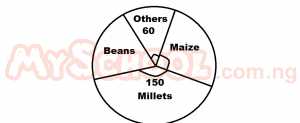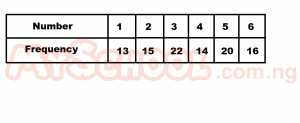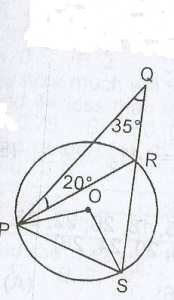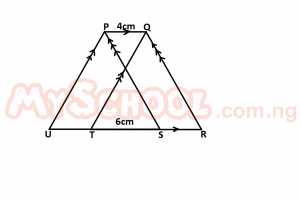I. Rectangular bars of equal width
II. The height of each rectangular bar is proportional to the frequency of the corresponding class interval.
III. Rectangular bars have common sides with no gaps in between
A histogram is described completely by
- A. I, II and III
- B. I and II
- C. II and III
- D. I and III
The weight of 10 pupils in a class are 15 kg, 16 kg, 17 kg, 18 kg, 16 kg, 17 kg, 17 kg, 17 kg, 18 kg, and 16 kg. What is the range of this distribution?
- A. 4
- B. 3
- C. 1
- D. 2
A committee of six is to be formed by a state governor from nine state commissioners and three members of the state house of assembly. In how many ways can the members of the committee be chosen so as to include one member of the house of assembly
- A. 378 ways
- B. 462 ways
- C. 840 ways
- D. 924 ways
A container has 30 gold medals, 22 silver medals and 18 bronze medals. If one medals is selected at the random from the container, what is the probability that it is not a gold medal?
- A. 9/35
- B. 11/35
- C. 4/7
- D. 3/7
The mean age of a group of students is 15 years. When the age of a teacher, 45 years old, is added to the age of the students, the mean of their ages becomes 18 years. Find the number of the students in the group
- A. 9
- B. 7
- C. 42
- D. 15
In how many ways can 2 students be selected from a group of 5 students in a debating competition?
- A. 25 ways
- B. 10 ways
- C. 15 ways
- D. 20 ways

The pie chart above shows the distribution of the crops harvested from a farmland in a year. If 3000 tonnes of millet is harvested, what amount of beans is harvested
- A. 6000 tonnes
- B. 1500 tonnes
- C. 1200 tonnes
- D. 9000 tonnes

An unbiased die is rolled 100 times and the outcome is tabulated above.
What is the probability of obtaining a 5?
- A. 1/5
- B. 1/2
- C. 1/6
- D. 1/4
find the mean deviation of 1, 2, 3 and 4
- A. 2.5
- B. 2.0
- C. 1.0
- D. 1.5
Some white balls put in a basket containing twelve red balls and sixteen black balls. If the probability of picking a white ball from the baskets is \(\frac{3}{7}\), how many white balls were introduced?
- A. 12
- B. 21
- C. 28
- D. 32
Evaluate \(\int_{1}^{3}(x^2 – 1)dx\)
- A. \(\frac{2}{3}\)
- B. \(-\frac{2}{3}\)
- C. \(-6\frac{2}{3}\)
- D. \(6\frac{2}{3}\)
Find the derivatives of the function y = 2x\(^2\)(2x – 1) at the point x = -1?
- A. 18
- B. 16
- C. -4
- D. -6
What is the rate of change of the volume V of a hemisphere with respect to its radius r when r = 2?
- A. 8π
- B. 16π
- C. 2π
- D. 4π
Find the derivatives of (2 + 3x)(1 – x) with respect to x
- A. 6
- B. -3
- C. 1 - 6x
- D. 6x - 1
The locus of a point which is 5 cm from the line LM is a
- A. line distance 10 cm from LM and parallel to LM
- B. pair of line on opposite sides of LM and parallel to it, each distance 5 cm from LM
- C. line parallel to LM and 5 cm from LM
- D. pair of parallel lines on one side of LM and parallel to LM

P, R and S lie on a circle center as shown above while Q lies outside the circle. Find ∠PSO
- A. 45o
- B. 55o
- C. 35o
- D. 40o

Find the value of x in the figure above
- A. 15√6
- B. 20√6
- C. 3√6
- D. 5√6
Determine the locus of a point inside a square PQRS which is eqidistant from PQ and QR
- A. The diagonal QS
- B. the perpendicular bisector of PQ
- C. The diagonal PR
- D. side SR
Find the midpoint of the line joining P(-3, 5) and Q(5, -3).
- A. (1, 1)
- B. (2, 2)
- C. (4, 4)
- D. (4, -4)

In the diagram above, PQ = 4 cm and TS = 6 cm. If the area of parallelogram PQTU is 32 cm\(^2\), find the area of the trapezium PQRU
- A. 60 cm2
- B. 72 cm2
- C. 48 cm2
- D. 24 cm2


